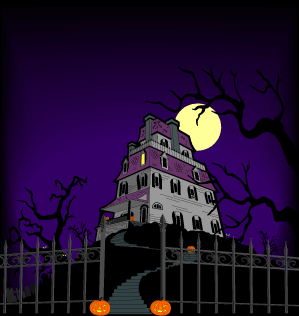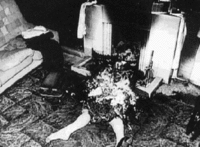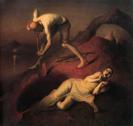Real Stories and Myths to talk about

My great-great grandmother, ill for quite some time, finally passed away after laying in a coma for several days. My great-great grandfather was devastated beyond belief, as she was his one true love and they had been married over 50 years. They were married so long it seemed as if they knew each other's innermost thoughts.
After the doctor pronounced her dead, my great-great grandfather insisted that she was not. They had to literally pry him away from his wife's body so they could ready her for burial.
Did You Know?It is a fact that once upon a time, before modern embalming techniques were developed, people were found on very rare occasions to have been buried alive. It's most likely, however, that 18th and 19th century horror stories involving premature burial were inspired by the medical discovery that victims of suffocation and drowning could be resuscitated — that though they appeared dead, they really weren't. This was a frightening realization for many people.
In any case, so strong was the fear of "precipitate interment" during the 19th century that some of the wealthier folk were known to stipulate in their wills that their coffins be outfitted with signaling devices ... just in case.
Further reading:
The Premature Burial - Short story by Edgar Allan Poe, 1850
Just Dying to Get Out - From the Urban Legends Reference Pages Now, back in those days they had backyard burial plots and did not drain the body of its fluids. They simply prepared a proper coffin and committed the body (in its coffin) to its permanent resting place. Throughout this process, my great-great grandfather protested so fiercely that he had to be sedated and put to bed. His wife was buried and that was that.
Did You Know?It is a fact that once upon a time, before modern embalming techniques were developed, people were found on very rare occasions to have been buried alive. It's most likely, however, that 18th and 19th century horror stories involving premature burial were inspired by the medical discovery that victims of suffocation and drowning could be resuscitated — that though they appeared dead, they really weren't. This was a frightening realization for many people.
In any case, so strong was the fear of "precipitate interment" during the 19th century that some of the wealthier folk were known to stipulate in their wills that their coffins be outfitted with signaling devices ... just in case
The mummies were of two girls and a boy likely killed in a sacrificial ritual about 500 years ago. They had been preserved in ice-cold conditions at 6,700 metres (22,000 feet) and are the best-preserved mummies from South America's Incan civilisation. The mummies would have been kept in temperatures at -25 degrees Celsius six feet below the ground.
Their lungs were inflated (a rare find), hearts intact, blood in the arteries, and the internal organs were well preserved. "These mummies were actually found sitting in the fetal position, hard as a brick," Keith McKenney told @discovery.ca today. McKenney is a molecular biologist from George Mason University in Monassas, Virginia, who analysed the DNA from the mummies. "It is not clear what their cause of death was. They were probably drugged or semi-conscious."

Some occultists believe that the Ghoul superstition comes from wild animals that disturb graves at night. It is also seen as an embodiment of the natural fear and horror which a man feels when he fases a really dangerous desert.
Ghouls are considered to belong to a true monster race. Allegations that ghouls are created by contamination or when a mortal drinks the blood of a vampire are totally falsed.
 of relative eminence by the first half of the 13th century. Abandoning their tribal roots, they assumed the name of one of their estates (Bátor meaning 'valiant') as a family name. Their power rose to reach a zenith by the mid 16th century, but declined and faded to die out completely by 1658. Great kings, princes, members of the judiciary, as well as holders of ecclesiastical and civil posts were among the ranks of
of relative eminence by the first half of the 13th century. Abandoning their tribal roots, they assumed the name of one of their estates (Bátor meaning 'valiant') as a family name. Their power rose to reach a zenith by the mid 16th century, but declined and faded to die out completely by 1658. Great kings, princes, members of the judiciary, as well as holders of ecclesiastical and civil posts were among the ranks of  Jack the Ripper" is the popular name given to a serial killer who killed a number of prostitutes in the East End of London in 1888. The name originates from a letter written by someone who claimed to be the killer published at the
Jack the Ripper" is the popular name given to a serial killer who killed a number of prostitutes in the East End of London in 1888. The name originates from a letter written by someone who claimed to be the killer published at the  time of the murders. The killings took place within a mile area and involved the districts of Whitechapel, Spitalfields, Aldgate, and the City of London proper. He was also called the Whitechapel Murderer and "Leather Apron."
time of the murders. The killings took place within a mile area and involved the districts of Whitechapel, Spitalfields, Aldgate, and the City of London proper. He was also called the Whitechapel Murderer and "Leather Apron." Richard Burton's father, Joseph Netterville Burton, was a gentleman in an age when being a gentleman was a proper calling..." Click here to read parts of his bio"
During 1844 and 1845, Burton went out on expeditions for his superiors, to parts of Sind, into the Indine delta, up the Indus River, to the edges of Punjab and through the Baluchi hills. All the while, he was disguised as a Muslim, passing himself off as a laborer, a merchant or a dervish, a kind of vagabond-cum-holy man. He was never discovered as the Englishman he really was. The role of holy man was a welcome one for Burton, as he had a lifelong fascination with religion. He studied Islam, Sufism and Hinduism. He was so well versed in these religions that he was able to become accepted in their faiths by those who had been lifelong devotees.
While in India, he studied Hinduism. In 1834, Burton's Hindu teacher officially allowed him to wear the Brahminical thread, the janeo. This was no small achievement. The sacred cloth is only awarded to a member of the highest caste, the Brahmins. The only possible way to become part of this elite group, according to Hinduism, is to be born a Brahmin, or to die and be re-born as one. Learning to become a Brahmin is not an option. As Burton's biographer Edward Rice wrote, "This was a rare and unheard-of honor for a young man from another culture, another that bore much enmity to Hinduism and everything it represented. The janeo, Hindus emphasize, is a privilege never given to an outsider."Later, while living in Sind, Burton began to masquerade as a whirling dervish. The whirling dervish is an ecstatic dance in which the dervishes heat irons in a fire and stick them in their mouths, biting and licking them. They also stick swords in their bodies, covering themselves with wounds. Although these wounds are supposed to be completely healed by the shaykh's prayers, Burton was found, at the time of his death, with hundreds of mysterious scars all over his body.
As a Muslim, Burton immersed himself not only in religious studies and prayer, but in every aspect of religious life. As his biographer wrote, "To be initiated into Islam is one thing; to live as a Muslim was something more demanding. Islam is not only a religion; it is the very hearty of existence, of daily life, a way of speaking, of thinking, eating, sleeping, and defecating, of attitudes and outlook. Even the mention of the Holy Prophet Muhammad demanded the addition of the phrase, 'Peace be upon him!'"While practicing as a Sufi, Burton undertook the grueling Chilla, a 40-day feast, followed by sacred dancing, known as sama. Certainly, to go to such extreme lengths is remarkable. Burton could have stopped short of the many tests he imposed upon himself. Rice seems to think that Burton was, privately, a devout follower of all the religions he embraced. Rice interprets Burton's secret belief as Gnosticism, a mystical set of beliefs which transcends traditional religion. Jinx believes Rice is taking this theory too far. While Burton was in the holy city of Medina, he drank alcohol, a strictly forbidden practice among Muslims. And during his stay in Sind, Burton described himself in the third person as "a very clever gentleman, ,who knew everything. He could talk to each man of a multitude in his own language, and all of them would appear equally surprised by, and delighted with, him. Besides, his faith was every man's faith. He chanted the Koran, and the circumcised dogs considered him a kind of saint.
The Hindoos [sic] respected him, because he always had a devil in an inner room. At Cochin he went to the Jewish place of worship and read a large book, just like a priestá" Although Burton may have been fascinated by and perhaps to some measure believed in what he was studying, it is dubious that he felt true reverence for other cultures. Burton endured great hardships during his journeys. While en route to Medina, Burton's caravan was attacked. Shots were fired and twelve men perished in the skirmish, along with camels and other beasts of burden. Although Burton's travels to the holy cities of Medina and Mecca were ones in which the possibility of execution was a constant, they had been accomplished by several other Westerners in the past, most of whom had been sold into slavery by the Turks. There had also been a few Westerners who had traveled unmolested - always, of course, incognito. Burton often spoke of Johann Ludwig Burckhardt, a Swiss explorer who had traveled to Mecca in the early part of the 19th Century. As impressive as Burton's expeditions to Mecca and Medina were, and for all the fame they brought him, there was an even more elusive treasure Burton coveted, one feat that had never before been accomplished by any Westerner: to enter the forbidden city of Harar in East Africa. The legend of Harar held that if ever an outsider entered the city, it would fall within a generation. This indeed happened not too long after Burton penetrated its walls. All whites were forbidden entrance to the city, as were African Christians, such as the Abyssinians. The penalty for an outsider discovered inside, of course, was death.
Undaunted, Burton prepared a caravan for Harar and set out in 1854. Dressed to the nines in Arab garb, and insisting that his entourage masquerade as his followers, Burton invented for himself the persona of Haji Mirza Abdullah. The term haji referred to the fact that he had completed journey, or hajj, to Mecca. Haji is a title of great honor. 
Sir Richard Francis Burton's life was one continuous adventure, ... Becomes aMaster Sufi. 1850. Returns to England. 1851
Seekers of Truth
Click here to read more
The founders of the American republic, as high-degree Freemasons, were aware of the importance of Moorish wisdom and culture to the birth of Western civilisation. This may explain why Morocco was the first nation in history to recognise the United States, and what’s really behind the story of George Washington being presented with a Moorish flag. Some researchers believe this flag consisted of a red background with a green five-pointed star in the centre of it. The star or pentagram, which the Moors called the Seal of Sulaiyman and coloured green to honour Islam, also figures prominently in Masonic art and architecture. The layout of the city of Washington D.C. – designed by Freemasons – incorporates the pentagram.
When Freemasons travelling in the Moorish lands encountered Sufis, the mystics of Islam, they soon recognised a common bond. “Sufi-ism,” said Sir Richard Burton, was “the Eastern parent of Freemasonry.” John Porter Brown, an American diplomat in Turkey in the mid 1800s, was a Freemason who wrote sympathetically of the Sufi path. In The Darvishes, he admits finding it “rather strange that the Dervishes of the Bektashi Order consider themselves quite the same as the Freemasons, and are disposed to fraternize with them.” Brown commented how in Turkey Freemasonry had come to be generally regarded as “atheism of the most condemnable character.” A position not unlike the one held by Papus, the celebrated French occultist and Gnostic bishop, who tried to counter the Masonic lodges which, he believed, were in the service of British imperialism and the international financial syndicates. Papus also viewed Freemasonry as a diabolical perversion of the ancient secret tradition and atheistic at heart. Click here to read more
Interesting facts of Sir Ricard Burton lay here within this story by Wright Click here to read about his failing health... the year 1888!
Last of the Murders in 1888 read each here:
The second woman to be victimized by Jack the Ripper was a woman by the name of Annie Chapman. She was found on the September 8, 1888 at Hanbury Street (http://ripper.wildnet.co.uk/ripintro.htm).
She was strangled, which prevented any form of screaming, and her throat was sliced almost to the spinal cord in her neck (Begg 59). Her abdomen had been cut open and the severed intestines were draped over her shoulder (Abrahamsen 60).
The next two murders are considered the "double murder," because they occurred on the same date. September 30, 1888 Elizabeth Stride was discovered on Berner's Street (http://ripper.wildnet.co.uk/ripintro/htm). She was strangled and her throat was cut just as the others before her, but there was nothing that could be construed as body mutilation (http://ripper.wildnet.co.uk/ripintro.htm). it is speculated that either Ripper was interrupted before he had a chance to completely finish the murder, or that this is not the work of Jack the Ripper (Begg 123). Catharine Eddowes' body was also found on this date. Her body was uncovered at Mitre Square, and again, she had also been strangled. Her throat was cut, and corpse was horribly mutilated in a way unlike the previous victims (http://ripper.wildnet.co.uk/ripintro.htm).
The last of the five murders and the most horrid is that of Mary Jane (Marie Jeanette) Kelly, found on Friday November 9, 1888 (Abrahamsen 17). This was the only murder to have taken place in a room. Because of its complicated, almost surgical style, experts say that it must have taken over two hours to complete (http://ripper.wildnet.co.uk/ripintro/htm).

Burton died in Trieste on October 20, 1890. Translated the Arabian Nights and Karma Sultra a Sex Mannual before its time in London during the Rain of Queen Victoria .... And maybe the men within the Lodge began to use the area prositutes in the rites and acts of Karma Sutra....
1888 -- Unsolved murders of London prostitutes by "Jack the Ripper," suspected of being one of those implicated in the Cleveland Street Affair involving high-society Victorians and their patronage of a brothel staffed by messenger boys
On the Wall was written 'Jubela, Jubelo, Jubelum' "The Juwes"
First, Jubela "that my throat had been cut across, my tongue torn out, and my body buried in the rough sands of the sea, at low water mark, where the tide ebbs and flows twice in twenty-four hours, ere I had been accessory to the death of so good a man as our Grand Master, Hiram Abiff!"
The second, Jubelo "that my left breast had been torn open and my heart and vitals taken from thence and thrown over my left shoulder, carried into the valley of Jehosaphat, and there to become a prey to the wild beasts of the field and vultures of the air, ere I had conspired the death of so good a man as our Grand Master, Hiram Abiff!"
The third, Jubelum "that my body had been severed in two in the midst, and divided to the north and south, my bowels burnt to ashes in the center, and the ashes scattered by the four winds of heaven, that there might not the least track or remembrance remain among men, or Masons, of so vile and perjured a wretch as I am; ah, Jubela and Jubelo, it was I that struck him harder than you both. It was I that gave him the fatal blow; it was I that killed him outright;"
'The Legend of the Three Ruffians'
Followers of Sufic mysticism believe that the builders of King Solomon's temple were really Sufi architects incorporating the holy words of God in numerical equivalents expressed in temple measurements, making Freemasonry Arabic in origin. According to this view, the Saxon King Aethelstan (A.D. 894-939) introduced Masonry to England after learning of it from the Spanish Moors.
From around 1850 he has been a member to the Diogenes Council, although the nature of his contributions remains unknown. He had a split with Hockley around 1865 involving the Blake tarot and left the Council.
His Wife was Isabel Burton ... click here to read more
Why was his papers, translations and books burned by his Wife what were in them? 
For years Isabel Burton has been reviled by scholars and admirers of Sir Richard Francis Burton for allegedly burning her husband's diaries, papers, and manuscripts following his death on October 20, 1890. The image of Isabel, grief-stricken and desperate to purge her husband's workroom of sinful and scandalous manuscripts, was so deliciously romantic and horrifying that no one stopped to ask ... what exactly did Isabel burn, and why?
No one, that is, until Mary S. Lovell. In her book A Rage to Live, Lovell disputes the commonly-held belief that Isabel, in a fit of posthumous prudishness, made a great bonfire of her husband's unpublished papers. In the manner of a detective re-opening an old file, Lovell questions the accuracy of (and motivation behind) statements made by witnesses to "the widow's burning" and looks for new evidence in the case.
It is widely acknowledged by many scholars that Isabel spent 16 days sorting through and organizing the mountains of papers, books, and manuscripts that she and Richard had accumulated over several years in Trieste. Similarly, it is well documented that Richard left Isabel clear instructions regarding the destruction of his personal papers. Lovell points out that this was not the first time that Richard had asked Isabel to destroy his notes and papers. In fact, Isabel had been responsible for burning Richard's notes and letters on a number of occassions, notably when Richard left his consular positions in Brazil and Damascus.
If we equate Isabel's burning of Richard's documents with the modern practice of shredding old paperwork, her actions seem completely normal. They seem even more normal when you consider just how many papers, bills, letters, unfinished manuscripts, books, diaries, and scribbled notes that Richard had collected and produced during his consular tenure at Trieste. Lovell observes that Richard had 8,000 books in his personal library and that, in total, Isabel shipped 200 crates of books and papers from Trieste to England. Isabel was a practical woman, and it is patently ridiculous to expect that she would preserve every scrap of paper or book that Richard owned.
Doubts about Isabel's motivations and actions are not easily set aside, however. The heart of the controversy can be summed up in one question: what exactly did Isabel burn?
Osiris has been mentioned many times, but not in any detail until now. Osiris played a very important role in ancient Egypt and this carried over into the rituals and beliefs of Egyptians much later, as well. It was because of the legend of Osiris that Egyptians believed they had the right to be transformed and to live in the afterlife. The myth of Osiris is like every other Egyptian myth: the story has changed with every political change of power.
Osiris was the son of Geb and Nut and was born in Thebes in Upper Egypt. Upon his birth, his grandfather, Ra, pronounced him heir to his throne, and when Geb retired, Osiris assumed this role and took his sister, Isis, as queen. His first deed was to abolish cannibalism and teach the arts of agriculture. He built the first temples and laid down fair laws for his people. He was given another name at this point, Onnophris, meaning the "good one." In his role as the fourth divine pharaoh, this was Osiris’s name.
He left Isis to rule Egypt when he decided to spread his rule around the world. He returned only after civilizing the entire earth. He found that Isis ruled wisely and his kingdom was still in perfect order. However, it was at this point that his brother, Set, began plotting against him. There are many stories of how Osiris was killed. The most common is that Set held an extravagant banquet and invited Osiris. After the festivities were over, Set produced a magnificent coffin and offered it as a gift to whomever it fitted best. Of course, it had been built for Osiris’s form and when he got in it, Set shut the lid and threw it in the Nile river.
Set took Osiris’s place as king while the grieving Isis searched for Osiris’s rem ains. She found the body in a far away place called Byblos, brought it back to Egypt, and hid it in the marsh. Set found it, unfortunately, and tore the body in pieces, throwing them again into the river. Isis collected all the pieces except the genitals, which had been eaten by fish. She bandaged the body together again. This was the first mummy. This mummy then transformed an akh, and this form of Osiris traveled to the underworld to become king over and judge of the dead.
ains. She found the body in a far away place called Byblos, brought it back to Egypt, and hid it in the marsh. Set found it, unfortunately, and tore the body in pieces, throwing them again into the river. Isis collected all the pieces except the genitals, which had been eaten by fish. She bandaged the body together again. This was the first mummy. This mummy then transformed an akh, and this form of Osiris traveled to the underworld to become king over and judge of the dead.

Note... within my research it seems that some felt that Orsis was Apollo .... the Greece God.....
Apollo had the gifts of prophecy, musical and artistic inspiration, and healing. He was also a talented archer.
Zeus, the Supreme Being of all Olympus (where all of the immortal beings lived), threw thunderbolts that were made for him down at Olympus during a storm. (If you've ever seen Disney's Fantasia, you've seen a wonderful animation of this!) Once, Zeus hit Apollo's son with one of his thunderbolts, causing his death. Apollo was enraged, and so he shot some of the Cyclopes, the makers of Zeus's thunderbolts. This brought the wrath of Zeus down upon Apollo in full force, and he was banished from Olympus.
They wrote: (Click here for the full story) Then Cronus became the ruler, and upon marrying his sister Rhea he begat Osiris and Isis, according to some writers of mythology, but, according to the majority, Zeus and Hera, whose high achievements gave them dominion over the entire universe. From these last were sprung five gods, one born on each of the five days which the Egyptians intercalates: the names of these children were Osiris and Isis, and also Typhon, Apollo, and Aphrodite; and Osiris when translated is Dionysus, and Isis is more similar to Demeter than to any other goddess; and after Osiris married Isis and succeeded to the kingship he did many things of service to the social life of man.
14. Osiris was the first, they record, to make mankind give up cannibalism; for after Isis had discovered the fruit of both wheat and barley which grew wild over the land along with the other plants but was still unknown to man, and Osiris had also devised the cultivation of these fruits, all men were glad to change their food, both because of the pleasing nature of the newly-discovered grains and because it seemed to their advantage to refrain from their butchery of one another. 

A bishop, who must have been born in the early years of the fourth century; died in 371. His birthplace and the circumstances of his youth are unknown. He first appears in ecclesiastical history, in full maturity of strength and abilities, in 354 when he was deputed by Pope Liberius, with the priest Pancratius and the deacon Hilary, to request the Emperor Constantius to convene a council, to deal with the accusations directed against St. Athanasius and his previous condemnation. This council was convened at Milan. Lucifer there defended the Bishop of Alexandria with much passion and in very violent language, thus furnishing the adversaries of the great Alexandrian with a pretext for resentment and further violence, and causing a new condemnation of Athanasius. Constantius, unaccustomed to independence on the part of the bishops, grievously maltreated Lucifer and his colleague, Eusebius of Vercelli. Both were exiled, Lucifer being sent to Germanica, in Syria, and thence to Eleutheropolis in Palestine; he was finally relegated to the Thebaid.
In the course of this exile Lucifer wrote an extremely virulent pamphlet entitled "Ad Constantium Augustum pro sancto Athanasio libri II", an eloquent defence of Catholic orthodoxy, but in such exaggerated language that it overshot the mark and injured the cause it was meant to serve. Lucifer boasted of his work, and Constantius, tyrant that he was, refrained from further revenge. After the death of Constantius, Julian allowed all the exiles to return to their cities. Lucifer went to Antioch, and at once meddled in the dissensions which divided the Catholic party. He prolonged and embittered them by consecrating a bishop who appeared to him capable of continuing the opposition to the bishop and party which he judged the weaker under the circumstances. Incapable of tact, he aggravated the dissenters, instead of dealing cautiously with them in order to win them, and displayed special severity towards those Catholics who had wavered in their adherence to the Nicene Creed. About this time a Council of Alexandria presided over by St. Athanasius decreed that Arians renouncing their heresy should be pardoned and that bishops who, by compulsion, had temporized with heretics should not be disturbed. Against this indulgence Lucifer protested, and went so far as to anathematize his former friend, Eusebius of Vercelli, who carried out the decrees of the Council of Alexandria. Seeing that his extreme opinions won partisans neither West nor East, he withdrew to Sardinia, resumed his see, and formed a small sect called the Luciferians. These sectaries pretended that all priests who had participated in Arianism should be deprived of their dignity, and that bishops who recognized the rights of even repentant heretics should be excommunicated. The Luciferians, being earnestly opposed, commissioned two priests, Marcellinus and Faustinus, to present a petition, the wellknown "Libellus precum", to the Emperor Theodosius, explaining their grievances and claiming protection. The emperor forbade further pursuit of them, and their schism seems not to have lasted beyond this first generation.

Many people believe that Spontaneous Human Combustion was first documented in such early texts as the Bible, but, scientifically speaking, these accounts are too old and secondhand to be seen as reliable evidence.

The first reliable historic evidence of Spontaneous Human Combustion appears to be from the year 1673, when Frenchman Jonas Dupont published a collection of Spontaneous Human Combustion cases and studies entitled De Incendiis Corporis Humani Spontaneis. Dupont was inspired to write this book after encountering records of the Nicole Millet case, in which a man was acquitted of the murder of his wife when the court was convinced that she had been killed by spontaneous combustion. Millet, a hard-drinking Parisian was found reduced to ashes in his straw bed, leaving just his skull and finger bones. The straw matting was only lightly damaged. Dupont's book on this strange subject brought it out of the realm of folkloric rumor and into the popular public imagination.
On April 9, 1744, Grace Pett, 60, an alcoholic residing in Ipswich England, was found on the floor by her daughter like "a log of wood consumed by a fire, without apparent flame." Nearby clothing was undamaged.
In the 1800's is evidenced in the number of writers that called on it for a dramatic death scene. Most of these authors were hacks that worked on the 19th century equivalent of comic books, "penny dreadfuls", so no one got too worked up about it; but two big names in the literary world also used SHC as a dramatic device, and one did cause a stir.
The first of these two authors was Captain Marryat who, in his novel Jacob Faithful, borrowed details from a report in the Times of London of 1832 to describe the death of his lead character's mother, who is reduced to "a sort of unctuous pitchey cinder."
Twenty years later, in 1852, Charles Dickens used Spontaneous Human Combustion to kill off a character named Krook in his novel Bleak House. Krook was a heavy alcoholic, true to the popular belief at the time that SHC was caused by excessive drinking. The novel caused a minor uproar; George Henry Lewes, philosopher and critic, declared that SHC was impossible, and derided Dickens' work as perpetuating a uneducated superstition. Dickens responded to this statement in the preface of the 2nd edition of his work, making it quite clear that he had researched the subject and knew of about thirty cases of SHC. The details of Krook's death in Bleak House were directly modeled on the details of the death of the Countess Cornelia de Bandi Cesenate by this extraordinary means; the only other case that Dickens actually cites details from is the Nicole Millet account that inspired Dupont's book about 100 years earlier.








